
The Great Western Railway (GWR) was a British railway company that linked London with the southwest, west and West Midlands of England and most of Wales. It was founded in 1833, received its enabling act of Parliament on 31 August 1835 and ran its first trains in 1838 with the initial route completed between London and Bristol in 1841. It was engineered by Isambard Kingdom Brunel, who chose a broad gauge of 7 ft —later slightly widened to 7 ft 1⁄4 in —but, from 1854, a series of amalgamations saw it also operate 4 ft 8+1⁄2 in standard-gauge trains; the last broad-gauge services were operated in 1892.

4-4-0, in the Whyte notation, denotes a steam locomotive with a wheel arrangement of four leading wheels on two axles, four powered and coupled driving wheels on two axles, and no trailing wheels.

The first Locomotives of the Great Western Railway (GWR) were specified by Isambard Kingdom Brunel, but Daniel Gooch was soon appointed as the railway's Locomotive Superintendent. He designed several different 7 ft 1⁄4 in broad gauge types for the growing railway, such as the Firefly and later Iron Duke Class. In 1864 Gooch was succeeded by Joseph Armstrong who brought his standard gauge experience to the workshops at Swindon. To replace some of the earlier locomotives, he put broad gauge wheels on his standard gauge locomotives and from this time on all locomotives were given numbers, including the broad gauge ones that had previously carried just names.
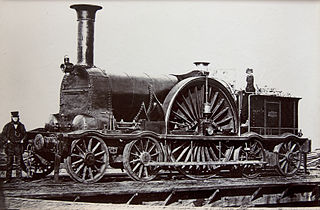
Under the Whyte notation for the classification of steam locomotives, 4-2-4 represents the wheel arrangement of four leading wheels on two axles, two powered driving wheels on one axle, and four trailing wheels on two axles.

Newton Abbot railway station serves the market town of Newton Abbot in Devon, England. It is 214 miles 5 chains (345 km) from London Paddington. The station today is managed by Great Western Railway, who provide train services along with CrossCountry.
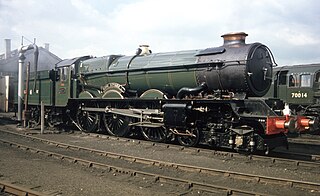
The Great Western Railway (GWR) 6000 Class or King Class is a class of 4-6-0 steam locomotives designed for express passenger work and introduced in 1927. They were the largest locomotives built by the GWR, apart from the unique Pacific. The class was named after kings of the United Kingdom and of England, beginning with the then reigning monarch, King George V, and going back through history. They handled the principal GWR expresses on the main line from London to the West of England and on the Chiltern line to Birmingham and Wolverhampton, until 1962 when the class was withdrawn.

Great Western Railway (GWR) 6000 Class King George V is a preserved British steam locomotive.
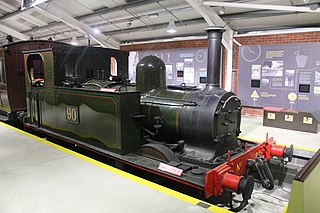
The Great Southern and Western Railway Class 90 is a class of 0-6-0T steam locomotive. They were one of the smallest steam locomotives to be inherited by the CIÉ on its formation.

The Dean Single, 3031 Class, or Achilles Class was a type of steam locomotive built by the British Great Western Railway between 1891 and 1899. They were designed by William Dean for passenger work. The first 30 members of the class were built as 2-2-2s of the 3001 Class.

The Bristol and Exeter Railway locomotives worked trains on the Bristol and Exeter Railway from 1 May 1849 until the railway was amalgamated with the Great Western Railway on 1 January 1876.

The 14 Bristol and Exeter Railway 4-2-4T locomotives were broad gauge 4-2-4T steam locomotives built to three different designs. The first entered service in 1853. The Bristol and Exeter Railway was amalgamated into the Great Western Railway on 1 January 1876, and the last of the 4-2-4Ts was withdrawn in 1885.
Railmotor is a term used in the United Kingdom and elsewhere for a railway lightweight railcar, usually consisting of a railway carriage with a steam traction unit, or a diesel or petrol engine, integrated into it.
The South Devon Railway Company built and operated the railway from Exeter to Plymouth and Torquay in Devon, England. It was a 7 ft 1⁄4 in broad gauge railway built by Isambard Kingdom Brunel.
Boulton's Siding was a British locomotive-hire business owned by Isaac Watt Boulton and situated alongside the Oldham branch of the Manchester, Sheffield and Lincolnshire Railway at Ashton-under-Lyne. It operated from 1864 to 1898.
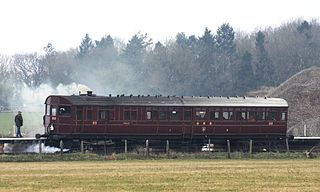
The steam rail motors (SRM) were self-propelled carriages operated by the Great Western Railway in England and Wales from 1903 to 1935. They incorporated a steam locomotive within the body of the carriage.

Baulk road is the name given to a type of railway track or 'rail road' that is formed using rails carried on continuous timber bearings, as opposed to the more familiar 'cross-sleeper' track that uses closely spaced sleepers or ties to give intermittent support to stronger rails.
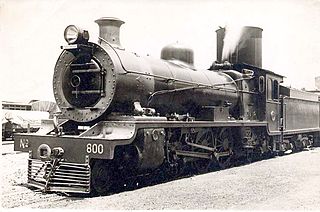
The South African Railways Class 16 4-6-2 of 1914 was a steam locomotive.

A steam railcar is a rail vehicle that does not require a locomotive as it contains its own steam engine. The first steam railcar was an experimental unit designed and built in 1847 by James Samuel and William Bridges Adams. In 1848, they made the Fairfield steam carriage that they sold to the Bristol and Exeter Railway, who used it for two years on a branch line.
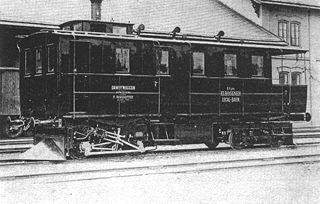
A steam railcar, steam motor car (US), or Railmotor (UK) is a railcar that is self powered by a steam engine. The first steam railcar was an experimental unit designed and built in 1847 by James Samuel and William Bridges Adams in Britain. In 1848 they made the Fairfield steam carriage that they sold to the Bristol & Exeter Railway, who used it for two years on a branch line.

The Indian locomotive class SP were a class of 4-4-0 passenger broad-gauge locomotives introduced around 1905 that were one of seven standard locomotive designs developed by the British Engineering Standards Committee (BESC) for the broad-gauge railways of British India.















